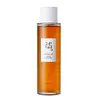What's inside
What's inside
 Key Ingredients
Key Ingredients

 Benefits
Benefits

 Concerns
Concerns

No concerns
 Ingredients Side-by-side
Ingredients Side-by-side

Panax Ginseng Root Water
MaskingButylene Glycol
HumectantGlycerin
HumectantPropanediol
SolventNiacinamide
Smoothing1,2-Hexanediol
Skin ConditioningWater
Skin ConditioningHydroxyacetophenone
AntioxidantGlyceryl Glucoside
HumectantXanthan Gum
EmulsifyingPanthenol
Skin ConditioningDipotassium Glycyrrhizate
HumectantAllantoin
Skin ConditioningAdenosine
Skin ConditioningPanax Ginseng Callus Culture Extract
Skin ConditioningTheobroma Cacao Extract
Skin ConditioningDextrin
AbsorbentGlucose
HumectantPanax Ginseng Root Extract
EmollientPanax Ginseng Berry Extract
Skin ConditioningLactobacillus
Skin ConditioningSodium Hyaluronate
HumectantEthylhexylglycerin
Skin ConditioningDisodium EDTA
Panax Ginseng Root Water, Butylene Glycol, Glycerin, Propanediol, Niacinamide, 1,2-Hexanediol, Water, Hydroxyacetophenone, Glyceryl Glucoside, Xanthan Gum, Panthenol, Dipotassium Glycyrrhizate, Allantoin, Adenosine, Panax Ginseng Callus Culture Extract, Theobroma Cacao Extract, Dextrin, Glucose, Panax Ginseng Root Extract, Panax Ginseng Berry Extract, Lactobacillus, Sodium Hyaluronate, Ethylhexylglycerin, Disodium EDTA
Acer Mono Sap
Skin ConditioningButylene Glycol
HumectantGlycerin
Humectant1,2-Hexanediol
Skin ConditioningWater
Skin ConditioningDipropylene Glycol
HumectantSea Water
HumectantPolyglyceryl-10 Laurate
Skin ConditioningCentella Asiatica Leaf Extract
Skin ConditioningCarbomer
Emulsion StabilisingPanthenol
Skin ConditioningTromethamine
BufferingCellulose Gum
Emulsion StabilisingEthylhexylglycerin
Skin ConditioningSodium Phytate
Oryza Sativa Extract
AbsorbentZea Mays Germ Extract
Skin ConditioningOryza Sativa Bran Extract
Skin ConditioningGlycine Soja Seed Extract
Skin ConditioningTriticum Vulgare Flour Extract
Skin ConditioningFructan
Skin ConditioningVitis Vinifera Fruit Extract
Skin ConditioningTocopherol
AntioxidantCreatine
Skin ConditioningCastanea Sativa Bark Extract
Skin ConditioningVaccinium Vitis-Idaea Fruit Extract
AntioxidantOlea Europaea Fruit Extract
BleachingRibes Nigrum Fruit Extract
AstringentBetula Alba Bark/Leaf Extract
AstringentPinus Sylvestris Bark Extract
PerfumingCaprylyl Glycol
EmollientBiosaccharide Gum-4
Skin ConditioningPropylene Glycol
HumectantSodium Hyaluronate
HumectantParfum
MaskingAcer Mono Sap, Butylene Glycol, Glycerin, 1,2-Hexanediol, Water, Dipropylene Glycol, Sea Water, Polyglyceryl-10 Laurate, Centella Asiatica Leaf Extract, Carbomer, Panthenol, Tromethamine, Cellulose Gum, Ethylhexylglycerin, Sodium Phytate, Oryza Sativa Extract, Zea Mays Germ Extract, Oryza Sativa Bran Extract, Glycine Soja Seed Extract, Triticum Vulgare Flour Extract, Fructan, Vitis Vinifera Fruit Extract, Tocopherol, Creatine, Castanea Sativa Bark Extract, Vaccinium Vitis-Idaea Fruit Extract, Olea Europaea Fruit Extract, Ribes Nigrum Fruit Extract, Betula Alba Bark/Leaf Extract, Pinus Sylvestris Bark Extract, Caprylyl Glycol, Biosaccharide Gum-4, Propylene Glycol, Sodium Hyaluronate, Parfum
 Reviews
Reviews

Ingredients Explained
These ingredients are found in both products.
Ingredients higher up in an ingredient list are typically present in a larger amount.
1,2-Hexanediol is a synthetic liquid and another multi-functional powerhouse.
It is a:
- Humectant, drawing moisture into the skin
- Emollient, helping to soften skin
- Solvent, dispersing and stabilizing formulas
- Preservative booster, enhancing the antimicrobial activity of other preservatives
Butylene Glycol (or BG) is used within cosmetic products for a few different reasons:
Overall, Butylene Glycol is a safe and well-rounded ingredient that works well with other ingredients.
Though this ingredient works well with most skin types, some people with sensitive skin may experience a reaction such as allergic rashes, closed comedones, or itchiness.
Learn more about Butylene GlycolEthylhexylglycerin (we can't pronounce this either) is commonly used as a preservative and skin softener. It is derived from glyceryl.
You might see Ethylhexylglycerin often paired with other preservatives such as phenoxyethanol. Ethylhexylglycerin has been found to increase the effectiveness of these other preservatives.
Glycerin is already naturally found in your skin. It helps moisturize and protect your skin.
A study from 2016 found glycerin to be more effective as a humectant than AHAs and hyaluronic acid.
As a humectant, it helps the skin stay hydrated by pulling moisture to your skin. The low molecular weight of glycerin allows it to pull moisture into the deeper layers of your skin.
Hydrated skin improves your skin barrier; Your skin barrier helps protect against irritants and bacteria.
Glycerin has also been found to have antimicrobial and antiviral properties. Due to these properties, glycerin is often used in wound and burn treatments.
In cosmetics, glycerin is usually derived from plants such as soybean or palm. However, it can also be sourced from animals, such as tallow or animal fat.
This ingredient is organic, colorless, odorless, and non-toxic.
Glycerin is the name for this ingredient in American English. British English uses Glycerol/Glycerine.
Learn more about GlycerinPanthenol is a common ingredient that helps hydrate and soothe the skin. It is found naturally in our skin and hair.
There are two forms of panthenol: D and L.
D-panthenol is also known as dexpanthenol. Most cosmetics use dexpanthenol or a mixture of D and L-panthenol.
Panthenol is famous due to its ability to go deeper into the skin's layers. Using this ingredient has numerous pros (and no cons):
Like hyaluronic acid, panthenol is a humectant. Humectants are able to bind and hold large amounts of water to keep skin hydrated.
This ingredient works well for wound healing. It works by increasing tissue in the wound and helps close open wounds.
Once oxidized, panthenol converts to pantothenic acid. Panthothenic acid is found in all living cells.
This ingredient is also referred to as pro-vitamin B5.
Learn more about PanthenolSodium Hyaluronate is hyaluronic acid's salt form. It is commonly derived from the sodium salt of hyaluronic acid.
Like hyaluronic acid, it is great at holding water and acts as a humectant. This makes it a great skin hydrating ingredient.
Sodium Hyaluronate is naturally occurring in our bodies and is mostly found in eye fluid and joints.
These are some other common types of Hyaluronic Acid:
Learn more about Sodium HyaluronateWater. It's the most common cosmetic ingredient of all. You'll usually see it at the top of ingredient lists, meaning that it makes up the largest part of the product.
So why is it so popular? Water most often acts as a solvent - this means that it helps dissolve other ingredients into the formulation.
You'll also recognize water as that liquid we all need to stay alive. If you see this, drink a glass of water. Stay hydrated!
Learn more about Water